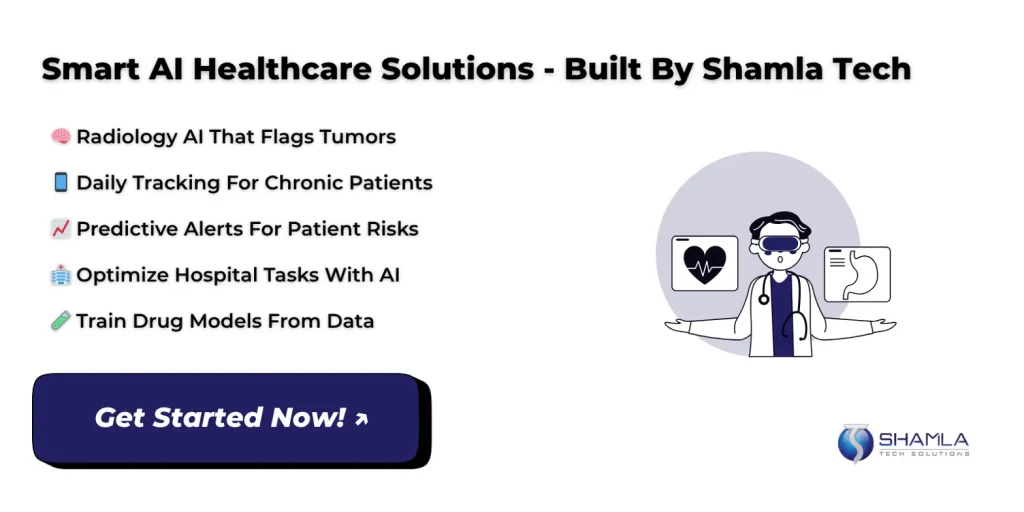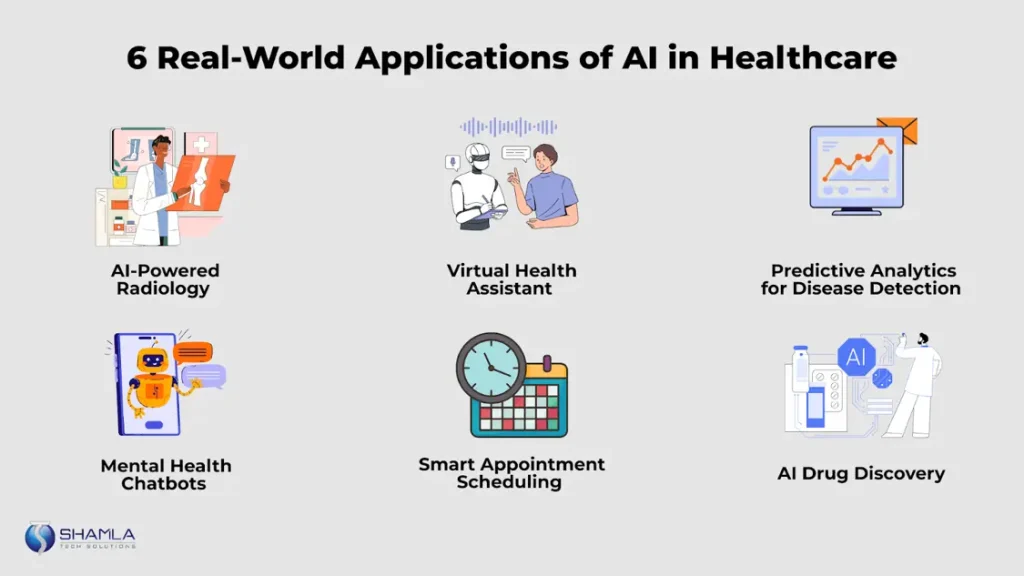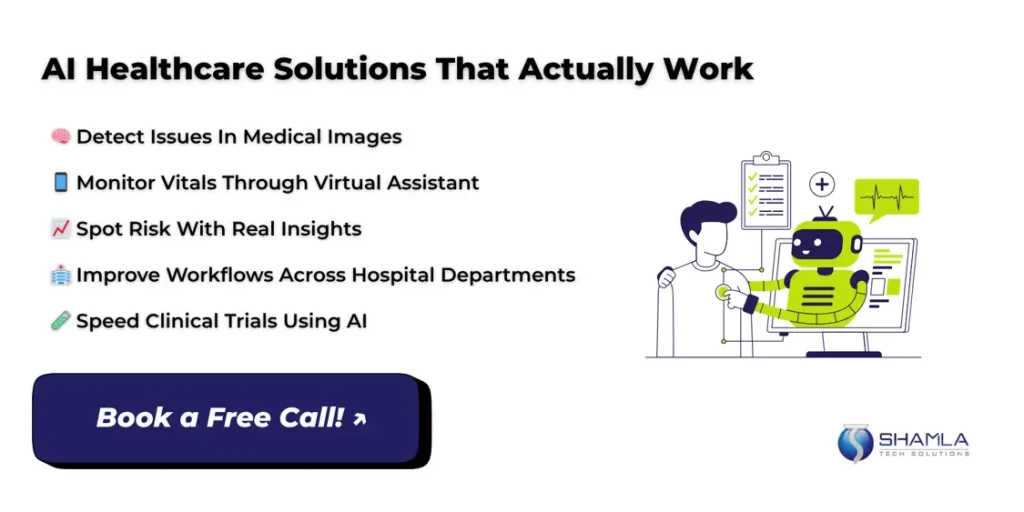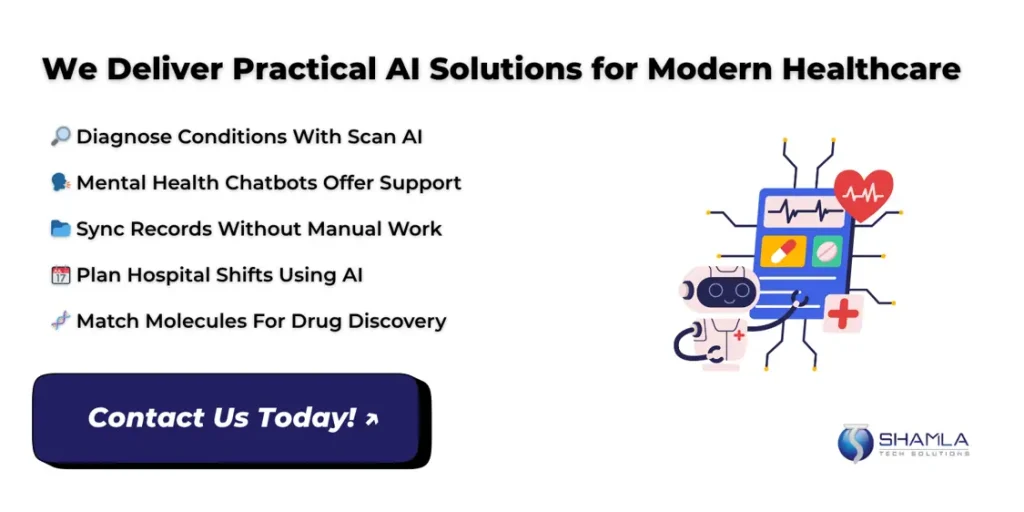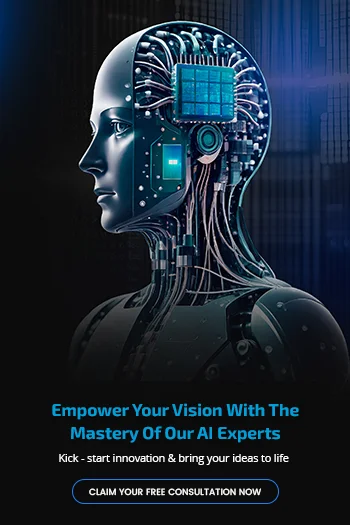From imaging scans powered by computer learning to simple models that flag at‑risk patients, artificial intelligence in healthcare is reshaping diagnosis and care. Developers can create tools that analyze medical images, track vital signs in real time, and recommend treatment paths. These platforms use pattern recognition, models, and automated workflows to speed up results while cutting errors.
With AI in healthcare expanding fast, hands‑on solutions are within reach. By building chatbots for triage or programs for workload planning, you can tackle administrative bottlenecks and improve patient interactions. This blog will guide you through practical projects to deliver efficient, life‑saving solutions.
The Impact of AI in Healthcare
1. Faster, More Accurate Diagnostics
2. Improved Patient Monitoring & Chronic Care
3. Administrative Automation & Reduced Errors
4. Personalized Treatment Plans with AI Algorithms
5. Better Resource Allocation in Hospitals
6 Real-World Applications of AI in Healthcare
1. AI-Powered Radiology Interpretation
AI for medical diagnostics helps doctors read scans fast. A system uses pattern analysis to mark tumors in X‑rays and MRIs. The tool learns from past cases and flags issues with split‑second speed. Radiologists see highlighted spots and notes. This boosts accuracy and cuts review time by half. Machines compare new scans to a huge library and point out odd shapes. Doctors trust this extra layer to catch hidden problems. The setup runs 24/7 and supports remote clinics. AI for medical diagnostics tools also learn from clinical feedback loops. This approach shows how artificial intelligence in healthcare speeds care today.
Radiology AI platforms plug into existing hospital systems. They accept DICOM images and return annotated scans within seconds. IT teams install modules via simple interfaces and train staff in hours. Reports are sent to the image archive with marked problem areas. Clinics connect them to patient records automatically. Remote doctors access scans on any device and share feedback. The AI updates as new data comes in and keeps getting better. Settings let users adjust sensitivity to specific tissues. Updates roll out quietly without downtime and patients get results faster and face fewer exams.
2. Virtual Health Assistants for Chronic Patients
AI in patient care platforms chat with chronic patients via phone or app. They collect daily symptoms, medications, and mood logs through quick surveys. The system sends reminders and adjusts prompts based on responses. Machine learning spots warning signs and notifies nurses. Chat bots guide patients through exercises or diet tasks. These tools reduce manual check calls. Patients feel supported between visits and follow plans better. This shows how AI in healthcare boosts patient engagement and helps keep conditions stable. AI in patient care works nonstop.
Patients access virtual health assistants anytime by voice or text. The app monitors blood sugar, pressure, and pain levels without needing additional equipment. Alerts appear on dashboards for nurses and doctors who review trends daily. Care teams adjust drugs or suggest therapy immediately. Reports export to charts and share with family members. The tool logs every interaction and stores data securely. Simple setup runs on common smartphones. Usage drops in‑school visits and trips to clinics. Patients report fewer flare‑ups and feel safer. Connectivity with lab systems gives clear updates. This system saves time and cuts trips.
3. Predictive Analytics for Early Disease Detection
AI for medical diagnostics engines scan lab records and patient history to forecast illness before symptoms show. Algorithms spot small shifts in blood tests or heart signals that doctors might miss. The model trains on millions of data points and learns normal vs. urgent patterns. It issues risk scores and highlights key factors on simple charts. Alerts appear in clinical software and let teams act fast. Nurses get heads up to order extra tests or send alerts home. This real time analysis shows the future of AI in healthcare by focusing on prevention. AI for medical diagnostics directly saves lives.
In hospitals, data pipelines gather vitals, imaging, and lab feeds into a unified platform. Predictive modules clear noisy data and flag trends that need attention. Clinicians get daily summaries with risk levels for each patient. Teams create rules that trigger automatic reminders and book checkups without manual steps. The process works behind firewalls and meets privacy rules. Visual reports show trend lines and key metrics clearly. Staff use mobile alerts to triage care faster. This approach lowers emergency visits and stops conditions from worsening. IT staff monitor system health and tune parameters as patterns evolve. Quick updates keep forecasts sharp.
4. AI Chatbots for Mental Health Support
AI in patient care chatbots talk with users to offer mental health tips and track mood swings. These bots use natural speech prompts and simple questionnaires. They sense stress or sadness and respond with coping exercises or breathing guides. Each chat adapts using user feedback to suggest tools like journaling or stretching. Conversations log anonymously and feed clinician dashboards. Bots send check in messages daily and flag urgent alerts for therapists. Clinicians review chat notes. This shows artificial intelligence in healthcare can extend care beyond clinics. AI in patient care chatbots run nonstop and reach people who need help quickly.
Users start chats on web pages or mobile apps without waiting. Bot replies appear in seconds, making help feel instant. Sessions use secure channels and meet data rules. Patients can review past chats and watch progress charts. Families link accounts to support check-ins. The system logs trends and lets therapists jump into live chats when needed. Teams set escalation paths for crisis scenarios. Data exports fit common formats for analysis. These tools cut phone wait times and ease call center loads. Quick access boosts engagement and lowers drop off rates.
5. Smart Scheduling and Hospital Workflow Optimization
AI in healthcare schedulers use demand data and staff calendars to plan shifts and room use. The system pulls admission records, surgery lists, and clinic bookings. Then it suggests optimal slots and notifies teams by email or text. Managers approve or tweak plans with a click. The tool reruns every hour to handle emergencies and updates live. Reports export PDF. Historical trends help predict peak days and keep beds ready. This shows the future of AI in healthcare to fine tune operations. AI-based scheduling in healthcare reduces downtime and ensures steady movement of patients through the system.
Dashboards show room status, staff load, and upcoming procedures in one view. Alerts pop up for pending discharges or low supplies. Teams adjust orders and free beds without calls. Mobile apps let nurses claim tasks and record delays. The system links lab and pharmacy queues for test timings. Managers review charts to balance staff and equipment. Automated reports email shift briefs to supervisors. The tool runs in cloud or on site servers. Integrations work with common hospital software. This system reduces extra staffing costs and shortens patient delays. Fast updates help maintain efficient schedules.
6. AI Models for Drug Discovery & Clinical Trials
Teams use AI for medical diagnostics frameworks to scan chemical libraries and predict molecule activity fast. Models analyze compound structures and match patterns for binding strength. Training uses assay results and genomic data sets. The system ranks candidates by safety and efficacy scores. Automated pipelines run virtual tests to spot promising leads. Developers review top picks via dashboards with clear metrics. This method cuts lab cycles and lowers costs. Data storage links trial outcomes back to models for continuous learning. Teams refine signals. Labs confirm. Researchers say this marks the future of AI in healthcare for finding new drugs faster.
In clinical trials, adaptive designs use AI for medical diagnostics models to adjust groups and doses. Systems monitor patient responses and side effect reports in real time. They flag issues like toxicity or low response rates to tweak protocols. Data connects electronic records and patient wearables for clear tracking. Trial managers get alerts and updated stats on simple dashboards. Teams update code nightly. Stakeholders review data. This cuts trial time and reduces risk. Sponsors share findings with regulators via secure portals. This practice proves the future of AI in healthcare to refine treatments and bring safe drugs to market faster.
Conclusion
The future of AI in healthcare shows in AI in patient care tools linking devices, data, and teams to spot risk and boost care now. Real-time alerts guide doctors, automate checks, and track recovery. This shows the future of AI in healthcare by driving new solutions and making care safer.
Shamla Tech is an AI development company that offers AI healthcare solutions to help healthcare operations run smoothly and maintain patient safety. Our AI systems link records, schedule tasks, and watch vital signs without extra steps.
Build AI healthcare tools for faster care, fewer errors, and better patient tracking.
Contact us today to deploy smart, safe, and reliable AI healthcare solutions!
FAQs
How does AI improve healthcare systems and outcomes?
How does AI help in good health and well-being?
How is AI beneficial to public health?
What is the application of AI in health?
AI powers tools for scans, diagnosis, record analysis. Virtual assistants support patients; chatbots monitor symptoms. Predictive models forecast disease, optimize hospital operations. Drug discovery uses AI to speed new treatments.


